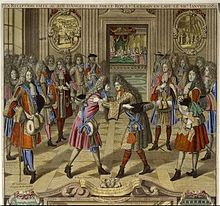A Brief History
On April 11, 1689, King James II of England, Scotland, and Ireland was deposed by his son-in-law and daughter, William III and Mary II who became joint sovereigns on this date. James II, the second son of King Charles I and younger brother of King Charles II, became King of England (and King James VII of Scotland) upon the death of Charles II. James II was a Roman Catholic, the last such monarch in England.
Digging Deeper
James II had generated suspicion and loathing among the mostly Protestant population of England and Great Britain, accused of being partial to Catholic France and of scheming to become an absolute monarch. James II produced a Catholic heir to the throne, a situation not amenable to English nobles. Those nobles encouraged William of Orange (Netherlands) and his wife Mary (daughter of James II, but Protestant) to invade England with an army in order to seize the throne with the support of English nobles, which they did. In the Glorious Revolution of 1688, James II was forced to flee England for his life, and was declared having abdicated by his absence. On April 11, 1689, William and Mary were crowned joint sovereigns of England, Ireland, and Scotland.

James II continued to sponsor battles for his throne in 1689 and 1690, but to no avail. James II lived with his cousin, King Louis XIV in France in exile as a pretender to the throne of England. He died in 1701 at the age of 67.

The reign of James II was marked by fighting with Parliament and his attempts to achieve religious freedom in Britain. James II had been born and raised Anglican but had been exposed to Catholicism while in exile in France during the Revolution and reign of Cromwell’s government. He converted to Catholic in 1668, a choice that would haunt his reign. James II only sat on the throne just under 4 years until his daughter and son-in-law took his throne with the help of English nobles. To this date, there has not been another English monarch of the Catholic faith, or for that matter any non-Protestant.
The Protestant tradition of the English throne goes back to King Henry VIII, who was named “Defender of the Faith” by the Pope and was stripped of that title when he broke with the Catholic Church over his right to divorce Catherine of Aragon. Queen Mary I was again the Catholic “Defender of the Faith” during her reign of 1553-1558, a brief return of a Catholic to the throne of England. Other than King James II, the monarchs of England have been of the Anglican Church and are considered “Defender of the Faith” of the Anglican Church, including the reigning Queen, Queen Elizabeth II.

Note: Despite Roman Catholic being the largest Christian denomination in the United States, only one President (John F. Kennedy) was of the Catholic faith. Oddly enough, the Supreme Court of the United States has been comprised of only Jewish and Catholic justices for several years now! (Since 2010, the first such occurrence in the History of the Supreme Court.)

Question for students (and subscribers): Do you wish England had a Catholic monarch today? Please let us know in the comments section below this article.
If you liked this article and would like to receive notification of new articles, please feel welcome to subscribe to History and Headlines by liking us on Facebook and becoming one of our patrons!
Your readership is much appreciated!
Historical Evidence
For more information, please see…
Ashdown, Dulcie. The Royal Line of Succession: The British Monarchy from Egbert AD 802 to Queen Elizabeth II. Pitkin, 1999.
Fry, PS. Kings & Queens of England and Scotland. DK; Revised ed., 2011.
The featured image in this article, a digital reproduction of a copper engraving of the Coronation procession of King James II and Queen Mary of Modena, 1685, is a faithful photographic reproduction of a two-dimensional, public domain work of art. The work of art itself is in the public domain for the following reason: This work is in the public domain in its country of origin and other countries and areas where the copyright term is the author’s life plus 100 years or fewer. This work is in the public domain in the United States because it was published (or registered with the U.S. Copyright Office) before January 1, 1924.

